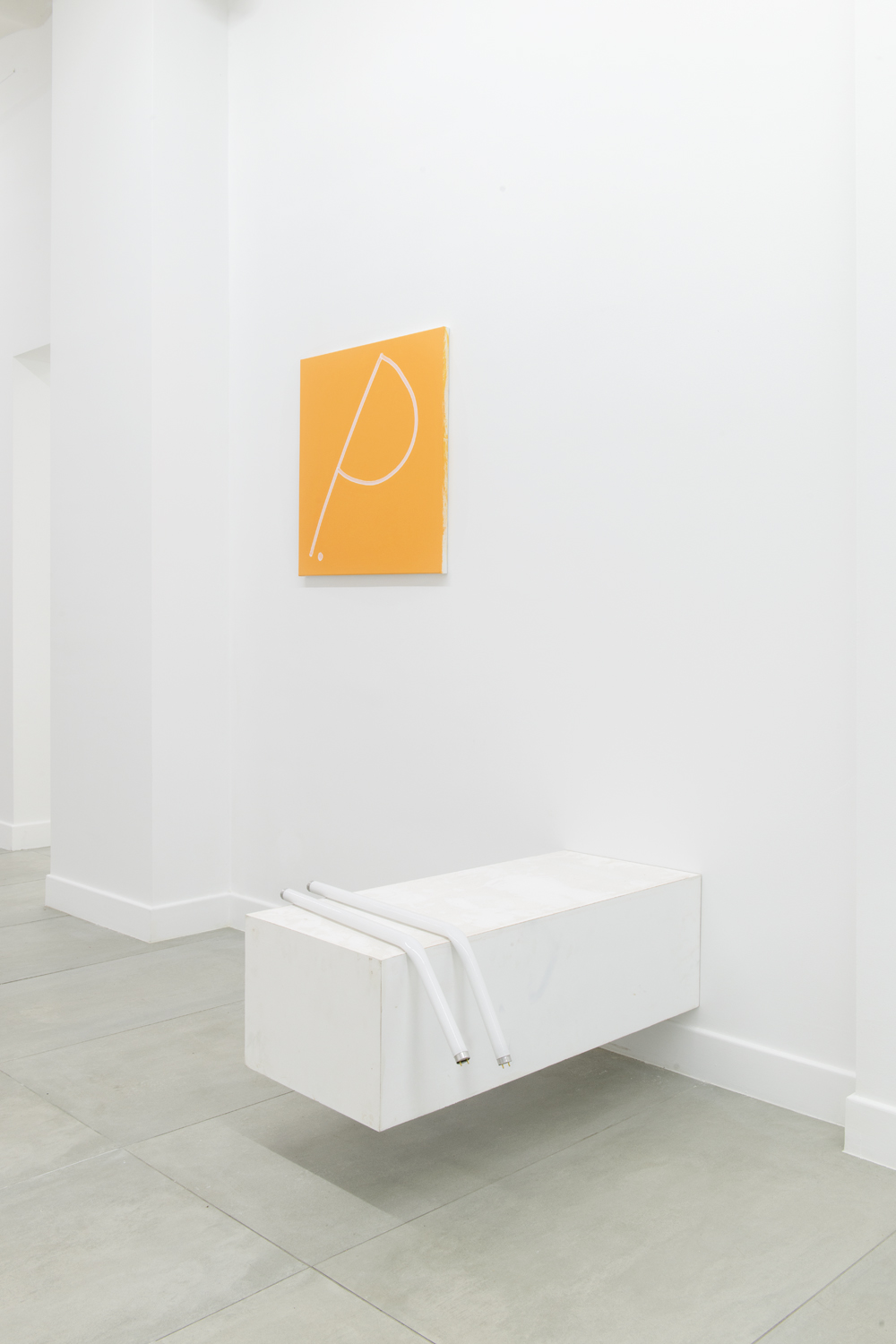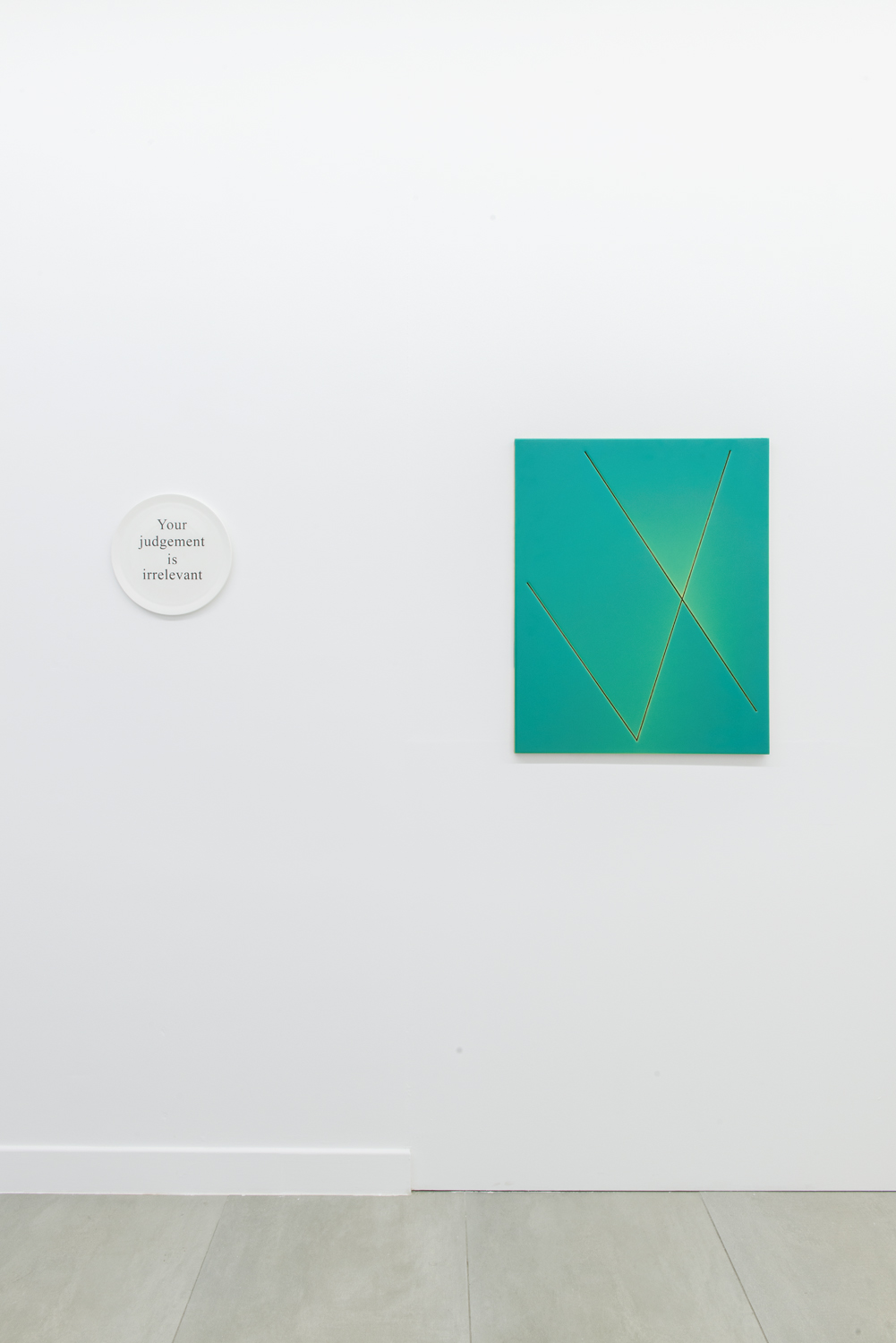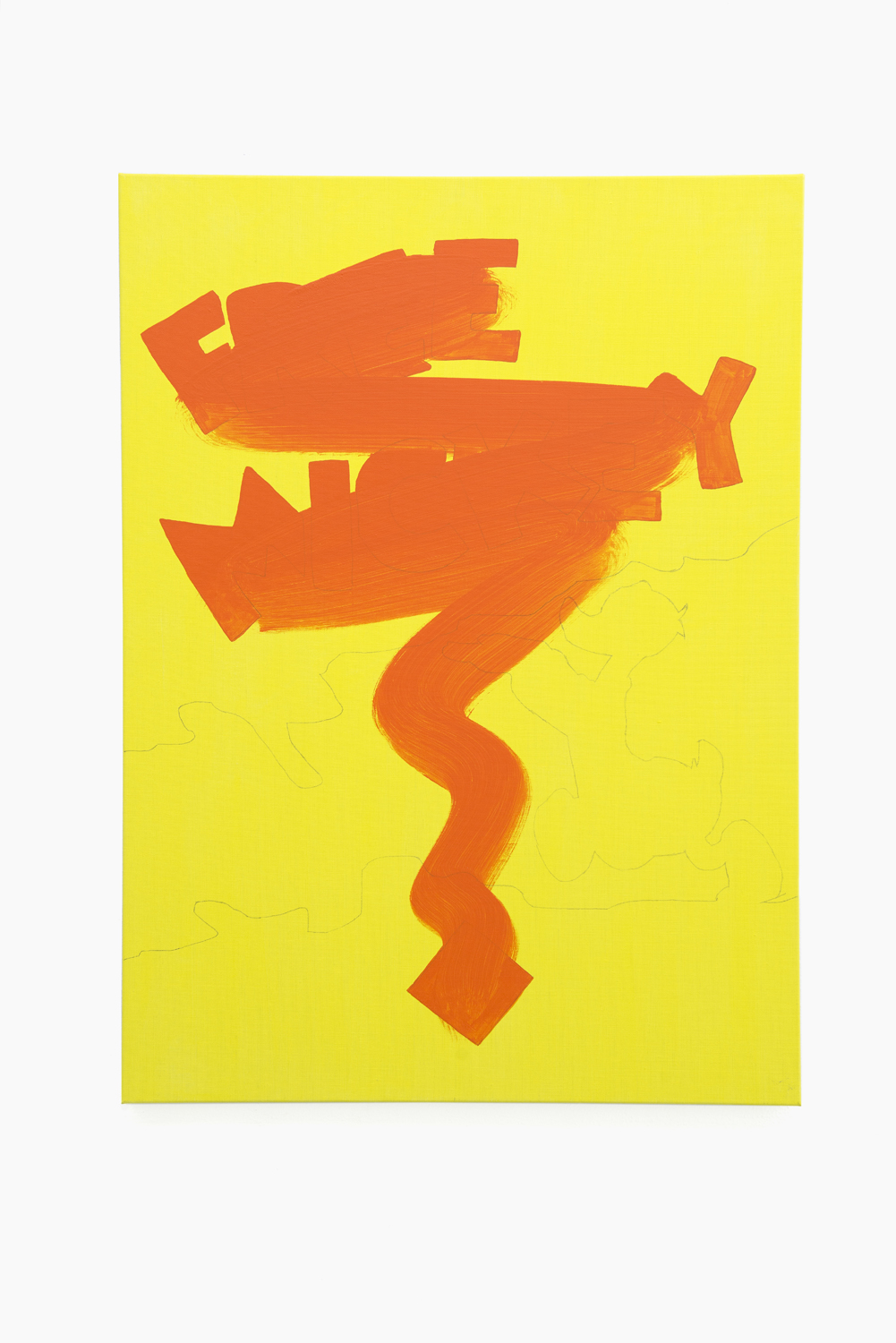Exhibition view (1st room), duo show Just Quist and Roeland Tweelinckx. Photo by Alexander Saenen. Barbé Urbain gallery, Gent, BE
‘ALLO, ‘ALLO
JUST QUIST ROELAND TWEELINCKX
14/09 - 20/10/2019
In their duo-exposition, Roeland Tweelinckx (Kontich, 1971) and Just Quist (Rotterdam, 1965) engage in a double play: paintings morph into sculptures, sculptures turn out to be part trompe l’oeil, and functional objects that appear to be part of the gallery space turn out to be parts of a sculptural installation. In Allo allo Tweelinckx and Quist join forces to redouble the impact of their individual aesthetic vision, and collectively they engage the visitor in a critical reflection in the predicament we find ourselves in, in a world saturated by digital images and self-representation and endless communication.
Roeland Tweelinckx, Replacements (2019).White beam, chair,80 x 50 x 78 cm
Most of the objects that populate the artistic universe of Roeland Tweelinckx appear to be functional apparatuses and objects: hot water radiators (found in most houses), medium sized ventilation grilles (found in office buildings around the world), red bricks and H-beams (staple products in housing construction), fire extinguishers, carton boxes... Not the kind of objects that make up the core of most contemporary mixed media sculptures, but essential elements of our everyday living environment. In addition, Tweelinckx’s more recent work incorporates more delicate and homely but still functional objects: abraded porcelain vases and plywood side tables found in thrift stores.
Taking his cue from these functional homely objects, Tweelinckx then takes two decisive steps that force us to ask difficult questions about the status or art (and art history) today and about how it relates to our post-digital world of simulacra and illusion.
Exhibition view (2nd room), duo show Just Quist and Roeland Tweelinckx. Photo by Alexander Saenen. Barbé Urbain gallery, Gent, BE
Roeland Tweelinckx, Things that you can rearrange, (2019) Glass, synthetic resin, pigment,wood and the existing wall
variable dimensions.
In a first step, Tweelinckx isolates these functional objects from their natural habitat. In that sense, his work seems to be a critical continuation of a well known Dadaist and surrealist practice, in which a found object is invested with almost magical qualities simply by taking it out of its ordinary context, stripping it from its functionality and placing it within the confined space of the museum.
But nothing is what it seems. Tweelinckx takes a decisive second step that renders his work deeply critical of both the Dadaist tradition and of the post-digital world we live in: he plays with trompe l’oeil and replication.
The force of the Dadaist’s found object depended upon it doing two things at once: while investing everyday objects with the secular magic of art, it also democratized art and criticized the elitist space of the museum. From now on, everything could potentially become art. But if all objects can potentially become art, this not only lends a certain aesthetic magic to the everyday living environment (a desired outcome for most Dadaists); ultimately, it also wears out the force of that aesthetic enchantment.
Exhibition view, duo show Just Quist and Roeland Tweelinckx. Photo by Alexander Saenen. Barbé Urbain gallery, Gent, BE
If everything is aesthetic, if everything is enchanted, and if everything is art – then, really, nothing is.
That issue becomes all the more pressing in a world in which the very status of objects has come into question and in which each and every one of our Instagram posts needs to feel enchanted.
Roeland Tweelinckx Brick (2019), baked clay, 40 x 49 x 14 cm.
While most found objects were industrially produced, they were also relatively unique – found in a specific place and time, limited in number and invested with an irreplaceable use value. In a world dominated by 3D printing, supply-on-demand and customized production and the hyper-illusionary world of digital emulation – in short, in our post-digital world the classical status of the object as something ‘real’, something undeniably material and unique (even if only through its use value) has disappeared. At the same time, everything we encounter in the digital domain is marketed as glamourous, as imbued with an aesthetic, as touching upon a whole way of living.
Installation view of Just Quist Untitled (2019), acrylics on canvas 68 x 64 cm and Roeland Tweelinckx Two small fluorenscent lamps (2019) wood, paint and acrylic tube. Variable dimensions
That is exactly the situation in which Tweelinckx work offers us a critical take on the Dadaist and surrealist tradition that marked the twentieth century. Because on closer inspection, the viewer is shocked to discover that Tweelinckx’s so-called found objects are not ‘found’ at all. In fact, they are perfect replicas of these objects; they are exact copies of everyday functional objects, executed with an unparalleled feel for replication and trompe l’oeil!
Rather than playing with (found) objects, Tweelinckx’ work plays with the illusion of there being ‘original’ and ‘found’ objects, forcing us to ask difficult questions about the post-digital world of simulacra we live in today. In doing so, his work opens the door for a revaluation of what has been seemingly been lost: rather than employing the aesthetic force of ordinary objects, as the Dadaists did, Tweelinckx’s work is a celebration of the critical capacity of images, simulacra and make belief that has always been at the heart of art. Now more than ever, his works seems to suggest, we need to draw upon these forces of art to obtain a critical attitude toward the world of commercial make- belief and delusional representation that inundate our social media accounts.
Installation view of Just Quist Untitled (2019) acrylics on canvas 92 x 67 cm and Roeland Tweelinckx Clip frame 001 (2019) wood, glas, paint and existing clips 8 x 40 x 50 cm.
Just Quist may at first sight appear to be a different sort of artist. Indeed, when it comes to the artistic techniques and materials he employs in his work, he is quite different.
Just Quist Untitled (so you are friends with camels) (2014) pacified steel 114 x 61 cm
Quist’s practice predominantly (though not exclusively) engages with the medium of painting and reflects on its history. But whoever looks at his work intently, quickly discovers that Quist’s artistic practice is driven by more conceptual questions: through his work Quist at one and the same time critically interrogates the modernist (mis)conception of materiality and the unique way in which representation and the illusion of immateriality function in our contemporary post-digital world.
From Mondrian to Rothko, the modernist tradition in painting tried to execute an impossible double move. On the one hand, it tried to bring painting back to the materiality of painting itself, creating a form of painting that represents nothing but itself; and in doing so, it hopes to exude a purely painterly presence. On the other hand, however, this painterly presence is bent on transcending materiality rather than simply affirming it; instead of a pure confrontation with materiality, the viewer standing in front of a Rothko painting is enraptured in an almost transcendental aesthetic experience.
Exhibition view (1st room), duo show Just Quist and Roeland Tweelinckx. Photo by Alexander Saenen. Barbé Urbain gallery, Gent, BE
But how are materiality and transcendent experience reconciled? Aren’t they mutually exclusive? How does modernist painting deal with that glaring contradiction?
Just Quist Schauw (2018) dyptich, acrylics on canvas, 67 x 136 cm
Well, it doesn’t. And yet this subtle contradiction has had a formidable impact on how we understand presence and materiality today - in a world dominated by social media and hyper- intensified self-representation. That is where Quist’s practice as an artist starts off. Quist uses the medium of painting to interrogate this paradox of materiality and representation, not just within the painterly tradition but in our social world and how it has been affected by the internet. The painterly and sculptural techniques he employs in his work are focused on highlighting that inevitable paradox of materiality and that still determines how we live in a post-digital world.
Quist’s use of glossy surfaces in several of his paintings, for example, is not just an intuitive aesthetic choice. Instead, it is a conceptual intervention that cuts to the heart of that paradox of materiality and representation: the glowing radiance of a glossy finish is the result of a material painterly procedure, but ironically it also gestures toward the idea of profane transcendence, representation and glamour that we known from so-called glossies, magazines that celebrate celebrity and leave us lingering for more of the same, and that has been transplanted to the glossy filters we employ on social media to enhance and enchant the images of our social lives. The glossy, Quists work suggest, always reflects the image of the viewer back – a feeble but unavoidable shadow of our own representation, of our own image, is always present in the glossy surface of the work.
Installation view of Roeland Tweelinckx, Your judgement (2019) D-print on ceramic edition of 2, ø 29 cm and Just Quist Untitled (transpire series) (2015) acrylics, epoxy, medium-density fiberboard, 77 x 61 cm.
Similarly, Quist’s works often uses words - not to communicate something, but to address the materiality of symbolic communication in post-digital times. The words found in Quist’s work make up slogans that provide the viewer with few clues or directions for interpretation; they create proper names that refer to non-existent persons (like ‘Rene Joffe’), they combine letters into words that do not seem to exist in any common language (like ‘schauw’). To these unusual procedures we can add the exceptional materials and shapes that Quist introduces in his paintings and sculptures, such as metal and medium-density fiberboard, and his conspicuous use of the frame and canvas stretchers.
Materiality, Quist suggests, is inescapable but always on the run: representations and images always occur.
Just Quist, Untitled, (deformation of intent) (2019) acrylics on canvas 92 x 67 cm
Quist’s conceptual take on painting and on artistic practice is not just a critical take on the paradoxes of modernist painting. Quite to the contrary, Quist’s work traces the way those paradoxes form part of a larger culture of representation that has come to dominate the way we present ourselves on social media and on the internet. As such, his work, much like that of Tweelinckx, combines a critical approach to the major tradition of twentieth century art with a genuine concern with the predicament we find ourselves in our own time.
(Text: Bram Ieven)
University Lecturer at the Leiden University Centre for the Arts in Society
CV Just Quist (link)
CV Roeland Tweelinckx (link)












